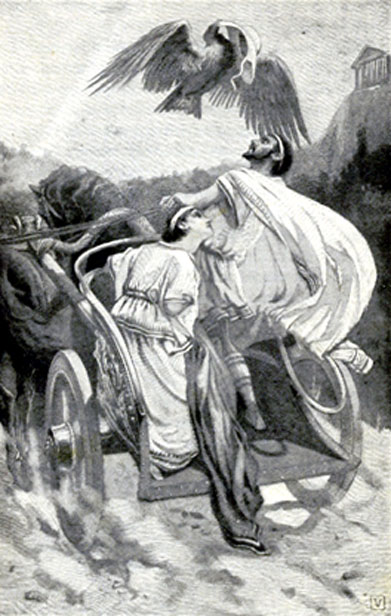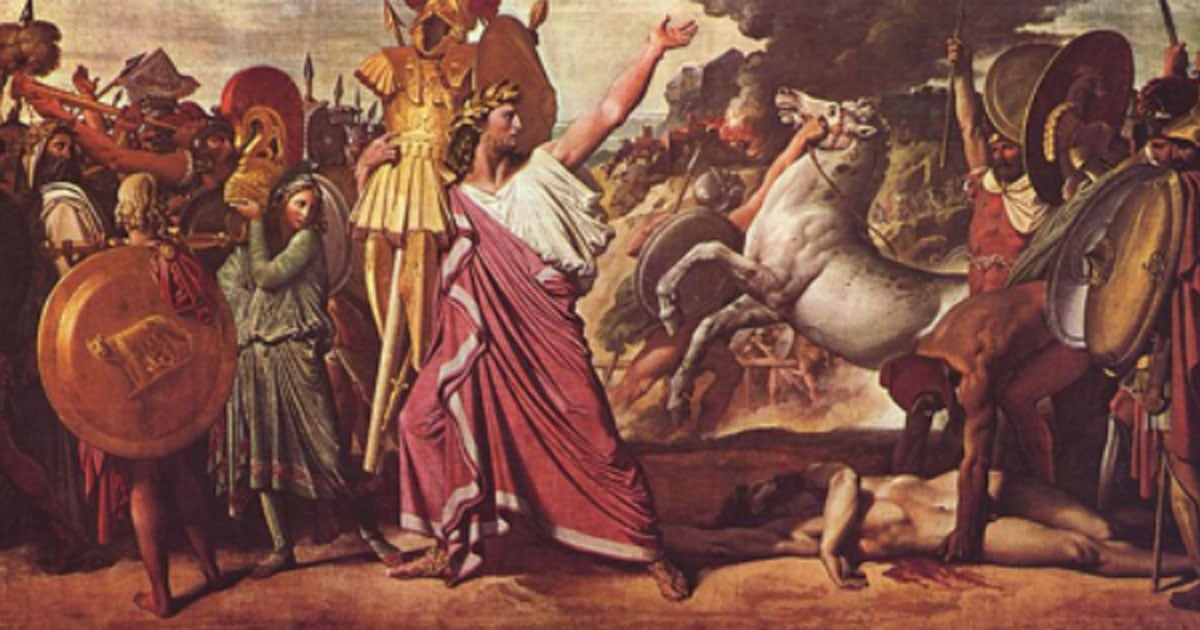The Seven Kings of Rome: Tumultuous Origins of the Roman Republic
In the beginning, there was only dirt and mud and twigs. Then came the legendary hero Aeneas, and from him descended the sons of Rhea Silva and Mars, the god of war. These sons were Romulus and Remus, the former becoming first of the seven kings of Rome. The story of these brothers marks the beginning of one of the most influential empires in the world.
But before Rome became an empire, it had very different origins. Long before Gaius Julius Caesar became dictator and his death at the hands of his senatorial "comrades", there was a different government in Rome. In the beginning, there was monarchy.
The Earliest of Rome’s Seven Kings
Romulus was the first of the seven kings of Rome. Founded with bloodshed and hate, Romulus' slaying of his twin brother Remus solidified him as the sole leader of the new country he chose to found on what would later be known as the Palatine Hill. Romulus kept his guards close, and his enemies closer—after all, founding a culture on the blood of your twin brother does not give the people you are ruling any sort of comfort. Yet the government he began would evolve…
- Ancient Journeys: What was Travel Like for the Romans?
- Built to Last: The Secret that Enabled Roman Roads to Withstand the Passage of Time
- Eating Like a Roman: Healthy Greens, Gritty Bread and Fish Paste – The Evolution of Ancient Roman Cuisine

‘The Pride of Romulus’ (16th century). (Public Domain)
After Romulus was swept away by the winds of the gods—or slain by the nobles who despised him (the more likely of the two options)—Numa Pompilius rose to the throne. A Sabine, Numa was the elected as king by the Senate. He was a man who was both cunning in politics and gentle in spirit. His reign was quite the opposite of Romulus'; guided by the wood nymph Egeria, Numa embraced the power of peaceful rulership over the war and bloodshed that tainted Romulus' reign.

Numa Pompilius was the second king of Rome, succeeding Romulus. (Public Domain)
After Numa came Tullus Hostilius, and after him Ancus Marcius. Hostilius, though much of his "history" has been confused with Romulus' (or vice versa), is remembered for two events: first, Hostilius likely brought down a large enemy settlement located in the Alban Mountains. The second event—and more reasonably occurring under Hostilius—is the building of the first proper Senate House. Initially, this location was called the Curia Hostilius and it continues to stand in the Roman Forum today (albeit with some structural alterations as necessary).

Tullus Hostilius defeating the army of Veii and Fidenae, modern fresco. (Public Domain)
Ancus Marcius, believed to be the first biologically related king of Rome, is primarily known for publicizing the religious works of Numa. Though genetic evidence is lacking, historical sources indicate that Numa was considered Ancus' grandfather; thus Ancus' decision to make Numa's religious reforms open to the public is a natural continuation of Numa's own work. Under Ancus, the largest port of Rome was built (Ostia), and war with the Latins continued in Rome's favor. Unfortunately, Ancus would be the last Roman king whose reign is not best recalled for a painful traitorous death.

Silver denarius struck in Rome 57 BC showing Ancus Marcius. (CC BY SA 4.0)
The Slow Demise of Roman Monarchy
Given the nature of Rome's foundations, it is somewhat more surprising that three kings escaped the same murderous death Romulus likely suffered. Lucius Tarquinius Priscus, king regent upon Ancus' death, was eventually elected as true king by the early Republican aspects of Rome's government.

Lucius Tarquinius Priscus and the eagle. (Public Domain)
During the period of the seven kings of Rome, alongside the monarchy there was a Senate, though its power was vastly different from what it would later become. The Senate had power in name alone, for the king could do as he pleased in all matters judicial, executive and military, however it was their responsibility to choose a candidate for king upon the death of the ruling monarch. This candidate was then "voted" for or against by the Curiate Assembly (or the people). It was the Senate and Curiate Assembly who gave power to Numa, Hostilius, Ancus and Priscus, and would have continued in this role had the sons of Ancus Marius not taken matters into their own hands.

‘Cicero Denounces Catiline’ (1889) by Cesare Maccari. (Public Domain) Representation of a sitting of the Roman Senate.
Upon the assassination of Priscus by Ancus' sons in his thirty-eighth year of power, the end of the monarchy slowly began. This was the first instance in which the established system of government was broken.
Priscus' reign is, like Tullius Hostilius', often confused with the reign of his successor once removed, Lucius Tarquinius Superbus. Both have had the draining of the Roman Forum attributed to them, both having been given credit for the excavation of the Cloaca Maxima (the great drain), and Priscus and Superbus are similarly given the same amount of credit for the creation of the Curcus Maximus. Therefore, the best way to distinguish their reigns is by their deaths.

Rome, the Tiber: the mouth of the Cloaca Maxima. (Public Domain)
Priscus, in an act he could never have foreseen, wed a woman clever enough to keep control of the city after his death. When assassinated, Tanaquil informed the public he was only injured and she chose the man to serve as his regent until Priscus recovered. This man was Servius Tullius, a commoner and Tanaquil's soon to be son-in-law, Tullius later became the proper "elected" king.
- The translation of the Gallic faith into the Roman pantheon
- Roman Engagement and Wedding Rings: Joining Hands and Hearts
- Analysis of Roman Coins Proves Roman Empire Got Rich on Iberian Silver

Servius Tullius was the sixth legendary king of ancient Rome and the second king of the Etruscan dynasty. (Public Domain)
From that moment however, the power of the Senate—unbeknownst to the Senate itself—became completely obsolete. Superbus later rose to power through the murder of Servius Tullius.
Though the monarchy of early Rome might have survived if not for the blasphemous actions of Superbus' son Sextus on the body of the good wife Lucretia, it undoubtedly would not have been around for much longer. The total and absolute control of the king over all matters was a frustration to the Senate and the Curiate Assembly even from the beginning, and those frustrations only grew—particularly as the later kings treated the role of king as something to be conquered.

‘Tarquinius Superbus makes himself King’ in The Comic History of Rome by Gilbert Abbott A Beckett. (ca. 1850) (Public Domain)
The rape of Lucretia by Superbus' son was not merely "the final straw" in a long coming revolution, but the moment the Roman people realized their own power; one king would not define them any longer. Lucretia's suicide spurred a rebellion, and the eventual defeat of Superbus led to the beginning of the Republic, itself preceding what would one day become one of the most influential empires in the ancient world.
Top Image: ‘Romulus' Victory Over Acron’ (1812) by Jean Auguste Dominique Ingres. Romulus was the first of the seven kings of Rome. Source: Public Domain
References
Cavazzi, F. 2012. “The Roman Kings.” Roman-Empire. http://www.roman-empire.net/kings/kings-index.html
Gantz, Timothy Nolan. 1975. “The Tarquin Dynasty.” Historia: Zeitschrift für Alte Geschichte. 24.4. pp. 539-554.
Morey, William C. 1901. Outlines of Roman History. Chicago: American Book Company. Accessed September 11, 2017. http://www.forumromanum.org/history/morey04.html
Nüssli, Christos. 1998. “Ancient Roman People.” Ancient-Rome. http://ancient-rome.com/ppl_f.htm
Plutarch. 1914. The Parallel Lives : The Life of Numa. Loeb Classical Library. Accessed September 10, 2017. http://penelope.uchicago.edu/Thayer/E/Roman/Texts/Plutarch/Lives/Numa*.html
Silk, Mark. 2004. “Numa Pompilius and the Idea of Civil Religion in the West.” Journal of the American Academy of Religion. 72.4. pp. 863-896.
Warren, Larissa Bonfante. 1970. “Roman triumphs and Etruscan Kings: The Changing Face of the Triumph.” The Journal of Roman Studies. 60.1 pp. 49-66.



















